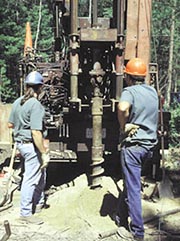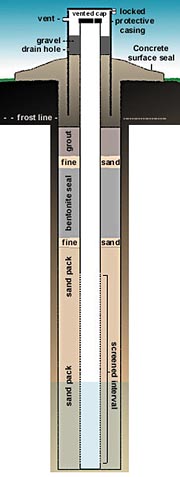

A locking protective steel casing is placed over the well and secured in a concrete surface seal to protect the well. A distinctive, readily visible marker is attached to the well for easy location. A vent hole is located near the top of the protective casing to prevent explosive gas buildup and to allow water levels to respond naturally to barometric pressure changes. The well cap also is vented. A drain hole is drilled at the base of the protective casing to prevent water buildup. The protective casing is filled with gravel. The concrete surface seal must extend below the frost depth, must be at least three feet across and must be sloped to drain water away from the borehole of the well.
The slot size of the well screen must be smaller than the surrounding sand pack. The sand pack acts as a filter. The screen length is dependent on the horizon to be monitored, but is less than 20 feet. The sand pack surrounding the well screen must be clean, inert, siliceous material. The grain size is based on the grain size of the material the well is drilled into and must minimize the amount of fine materials entering the well without inhibiting the inflow of ground water. The sand pack is placed in the annular space around the well screen and extends 2 feet (or 20% of the screen length - whichever is greater) above the top, and 6 inches below the bottom, of the screen. A finer grained sand pack material 6 inches thick is placed at the top of the sand pack between the sand and the bentonite seal. Bentonite is placed above the sand pack to form a seal at least 3 feet thick and a 6- to 12-inch fine grained sand pack is placed above the bentonite seal to minimize grout infiltration. Grout of cement/bentonite, bentonite alone, or other suitable, low permeability material completely fills the remaining annular space to the surface seal.
This article is provided through the courtesy of the New York State Department of Environmental Conservation. It is a brief reference excerpted from Part 360 of Title 6 of the Official Compilation of Codes, Rules and Regulations of the State of New York. To see the full description, visit www.dec.state.ny.us.

Report Abusive Comment